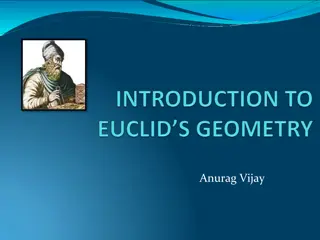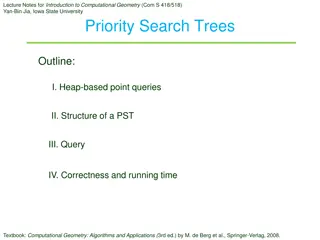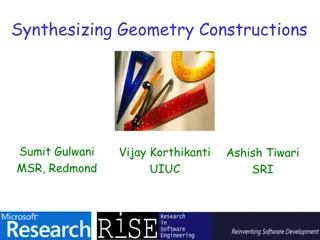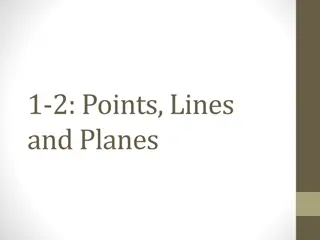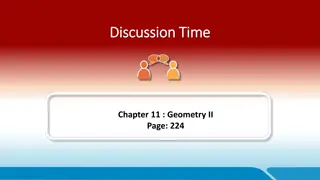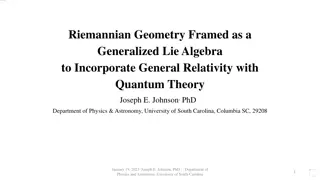Line Segment Intersection
Geometric intersections play a crucial role in computational geometry for tasks such as solid modeling, collision detection in robotics, and overlaying subdivisions in geographic information systems. The problem of line segment intersection involves finding all intersection points between a set of c
1 views • 17 slides
Introduction to Geometry Tools: Circle, Line, Perpendicular, and Angles
This content introduces essential geometry tools like the circle, line, perpendicular, and angles, with details on their construction and applications. Learn about rulers, compasses, protractors, and more for drawing shapes and measuring lengths and angles. Discover how to construct circles, line se
3 views • 12 slides
Circle Geometry Principles
Explore key concepts in circle geometry such as angles subtended at the center and circumference, cyclic quadrilaterals, properties of tangents and chords, and the significance of major and minor segments. Uncover relationships between angles, segments, and points on a circle, including alternate se
3 views • 8 slides
Autodesk Inventor Geometric Construction Tools Overview
Explore the functionality of Autodesk Inventor's geometric construction tools, such as applying geometry constraints, utilizing trim/extend and offset commands, understanding profile sketches, creating projected geometry, and editing sketches with click and drag. Discover how to enhance efficiency i
4 views • 12 slides
Line Sweep Algorithms in Geometry
Line sweep algorithms are a powerful tool for solving geometry problems by simulating the sweeping of a vertical line across a plane. This approach allows for efficient processing of important points and addressing various geometric challenges, such as finding the closest pair of points, determining
2 views • 10 slides
Euclid's Geometry: The Fundamentals Explained
Euclid, known as the Father of Geometry, introduced the principles of geometry in Egypt. His work included definitions, axioms, and postulates that laid the foundation for geometric reasoning. Euclid's Five Postulates are crucial in understanding the basic concepts of geometry. This article provides
2 views • 12 slides
Geometry Vocabulary with Mr. Fiore & Mr. Ryan
Geometry, the study of shapes, has its roots in Ancient Mesopotamia and Ancient Egypt. Concepts such as point, line, ray, endpoint, line segment, vertex, congruent, vertical line, horizontal line, and plane are essential in understanding geometric relationships and structures. This visual guide prov
2 views • 22 slides
Similar Polygons in Geometry
Explore the concept of similar polygons in geometry through a comprehensive slideshow developed to accompany the textbook "Big Ideas Geometry" by Larson and Boswell. Learn to identify corresponding lengths, perimeters, and areas of similar polygons, make similarity statements, and determine similari
0 views • 24 slides
Line and Staff Authority in Organizational Structure
Line authority flows from top to bottom in an organization, while staff authority is provided by specialists to advise line managers. Staff members offer expert advice and support to enhance the efficiency of line officials. Different types of staff positions exist, such as personal staff, specializ
2 views • 5 slides
Diverse High School Courses at BMV: Algebra, Geometry, Biology, Debate, Spanish
Explore a variety of high school courses at BMV including Algebra 1 Honors, Geometry Honors, Biology Honors, Debate, and Spanish 1. These courses offer a comprehensive range of subjects from math to language arts, preparing students for advanced studies and fulfilling graduation requirements. Studen
0 views • 19 slides
Insights from Geant4 Development Team on ATLAS Geometry Investigations
Investigating the ATLAS geometry using Geant4, the team from National Research Tomsk State University presented findings at the 23rd Geant4 Collaboration Meeting. They focused on solid methods, CPU consumption, and optimizing geometry descriptions to enhance simulation performance. Specifics of the
0 views • 40 slides
Practical Geometry Guide by S.N. Mishra
Practical Geometry Made by S.N. Mishra is a comprehensive guide that covers various aspects of practical geometry with detailed explanations and visual aids. The guide includes step-by-step instructions, illustrations, and practical examples to help users grasp the concepts easily. Whether you are a
1 views • 12 slides
Geometry Test Prep Questions
Prepare for your geometry test by reviewing essential questions on points, lines, planes, distances, and intersections. Use the provided images to practice concepts such as collinear points, intersecting lines, opposite rays, and more. Challenge yourself to solve distance problems without using form
1 views • 31 slides
Mathematical Foundations for Computer Graphics: Geometry, Trigonometry, and Equations
This lecture covers essential mathematical tools for computer graphics, including 2D and 3D geometry, trigonometry, vector spaces, points, vectors, coordinates, linear transforms, matrices, complex numbers, and slope-intercept line equations. The content delves into concepts like angles, trigonometr
1 views • 53 slides
Development of Plasma-Facing Geometry Design for W-Divertor in SOLTKT Fusion Reactor
Study on the plasma-facing geometry design based on power shell geometry in the SOL TKT W-divertor development for the fusion reactor. The research involves fundamental differences in divertor baffle design, materials used, heat load requirements, interface connections, and key design concerns. The
0 views • 14 slides
Introduction to Priority Search Trees in Computational Geometry
This lecture outlines the structure and query process of Priority Search Trees (PST) in computational geometry. It covers heap-based point queries, range trees for windowing queries, handling query ranges in 1D and 2D spaces, and using heaps to efficiently handle query ranges. The content discusses
1 views • 18 slides
Conditional Statements in Geometry
In this chapter of "Big Ideas Geometry," the focus is on conditional statements in geometry. Learn how to write conditional and biconditional statements, determine if statements are true or false, and explore logical implications such as converse and negation. Through examples and explanations, gras
0 views • 54 slides
Mastering Line and Triangle Geometry: Rules and Angle Calculations
Revisit the main rules and terms of line and triangle geometry to calculate angles. Understand types of angles, such as right, acute, obtuse, and reflex. Learn about various angle rules like angles on a straight line, angles at a point, vertically opposite angles, angles in a triangle, equilateral t
0 views • 46 slides
CFD Workshop on Geometry Generation and Meshing Techniques
This workshop focused on the use of geometry modeling and mesh generation techniques in Computational Fluid Dynamics (CFD) simulations. Participants discussed key questions, findings, lessons learned, supporting evidence, and future plans relating to geometry manipulation, mesh quality, and the impa
1 views • 8 slides
Geometry Constructions: A Synthesis of Theory and Practice
Explore the world of geometry constructions through ruler/compass-based techniques, combining logical reasoning and visual elements to create engaging exercises. Discover the programming language for constructing geometric shapes, with an example problem and a specification language for geometry pro
1 views • 25 slides
Geometry Concepts and Calculations Practice Questions
This content covers various topics in geometry, including decimal and fraction conversions, percentage calculations, along with missing angle calculations. It offers practice questions for students to enhance their understanding of geometry concepts.
0 views • 11 slides
Basics of Geometry: Understanding Points, Lines, and Planes
Explore the fundamental concepts of geometry in this slideshow developed to accompany the textbook "Big Ideas Geometry." Learn about points, lines, and planes, their characteristics, how they are named, and their relationships in space. Gain a clear understanding of line segments, rays, collinear po
1 views • 55 slides
Computational Geometry: Algorithms and Methods in Geometric Problem Solving
Explore the realm of computational geometry encompassing line segment crossing, convex hulls, Voronoi diagrams, and element distinctness reduction. Delve into techniques like line crossing checks, enumeration of cross points, and the sweep method, which are crucial for solving geometric problems eff
0 views • 32 slides
Circle Theorems and Pythagoras Theorem in Geometry
Explore the key concepts of circle theorems and Pythagoras theorem in geometry. Learn about the parts of a circle, properties of chords, the relationship between the radius and tangent, and how Pythagoras theorem can be applied to solve circle-related problems like finding distances and lengths. Eng
0 views • 8 slides
Properties of Circles in Geometry
Explore the key concepts and properties related to circles in geometry, such as tangents, diameters, secants, and common tangents. Discover how tangents interact with circles and learn about the relationships between radius, diameter, and chord lengths. Enhance your understanding of circle geometry
0 views • 48 slides
Circumference and Perimeter Calculations in Geometry
Explore various geometry problems involving calculating circumferences and perimeters of shapes and circles. Practice calculating diameters, radii, and distances moved in real-life scenarios. Test your knowledge with true or false questions related to geometry concepts.
1 views • 12 slides
Plane Sweep Algorithms in Computational Geometry
Plane sweep algorithms are a powerful technique in computational geometry for solving various problems efficiently. By simulating the sweep of a vertical line across the plane and maintaining a cleanliness property, these algorithms can process events at discrete points in time to update the status
1 views • 26 slides
Higher Level Flash Cards Quiz - Geometry and Mathematics
This set of flash cards quizzes your knowledge on various geometry and mathematics topics. From calculating exterior angles of polygons to determining the area of shapes and understanding correlations in graphs, test your understanding and learn new concepts. Sharpen your skills in geometry, trigono
0 views • 15 slides
Introduction to Points, Lines, and Planes in Geometry
Exploring the fundamental concepts of points, lines, and planes in geometry, including definitions, examples, and postulates. Learn about collinear points, coplanar points, segments, rays, and key postulates in geometry.
1 views • 18 slides
Geometry II - Understanding Lines and Arcs in a Circle
This content discusses concepts related to geometry, focusing on lines and arcs within a circle. It explores the properties of lines AB and APB, measures of angles AOB and APB, as well as the shapes formed within the circle. The discussion provides a clear understanding of the terminology and geomet
1 views • 4 slides
Introduction to Stereo Reconstruction in Computer Vision
This material covers the fundamental concepts in stereo reconstruction, including the pinhole camera model, perspective projection, epipolar geometry, essential and fundamental matrices, camera calibration, homography, and projective geometry. It also discusses stereo vision and 3D reconstruction fr
0 views • 41 slides
Optimizing Line Coding for PM-PHY: A Detailed Analysis
Enabling line coding and channel equalization methods for PM-PHY, the IEEE 802.15.13 standard introduces overhead while enhancing channel adaptation. This contribution proposes 64b67b and Uniform Line Coding as alternative transmission modes, aiming to reduce line coding overhead while maintaining a
0 views • 26 slides
Circles in Analytic Geometry
Explore the fundamentals of circles in analytic geometry by learning how to derive circle formulas, equation determination, completing the square, proving circle properties, and solving application problems. Discover the definition of a circle, its relation to triangles, and the terms, equations, an
0 views • 51 slides
Geometry Problems and Solutions
Explore a series of geometry problems involving special right triangles, hypotenuse lengths, leg measurements, and applications of triangle theorems. From finding the length of the hypotenuse to distance calculations on a softball diamond, challenge your geometry skills with these engaging problems.
0 views • 9 slides
The Ham-Sandwich Theorem in Computational Geometry
The Ham-Sandwich Theorem states that given two finite point sets in the plane, there exists a line that divides each set such that each side contains at most half of the points in that set. The proof involves finding such a line and rotating it to maintain the property. This concept is essential in
1 views • 19 slides
Geometry Standards of Learning Practice Problems
Explore practice problems related to Geometry Standards of Learning (SOL), covering topics such as symbolic representation of arguments, laws of detachment, contrapositive, syllogism, counterexamples, and geometric proofs. Test your understanding of angles, lines, transversals, and congruence to str
0 views • 50 slides
Incorporating General Relativity into Quantum Theory through Riemannian Geometry
Framing Riemannian Geometry as a Generalized Lie Algebra to combine General Relativity with Quantum Theory. The proposal extends Heisenberg Algebra to incorporate a more general geometry, allowing for a function of position in commutator relationships. The discussion covers historical developments,
0 views • 50 slides
Coordinate Geometry: Line Solutions Revision
In this section, you will find solutions and exam-style questions related to coordinate geometry focusing on lines. Topics covered include determining values, investigating perpendicular lines, finding equations of lines passing through points, and plotting points. The explanations provided will hel
0 views • 81 slides
Line Judge Responsibilities in Volleyball
In volleyball, line judges play a crucial role in assisting the first referee during matches. They must be carefully selected, trained, and coordinated to ensure fair play. Schools are responsible for recruiting and training line judges, preferably adults, well before the season starts. The first re
0 views • 23 slides
Introduction to Computational Geometry: Line Arrangements and Discrepancy Problems
Explore the complexity and construction of line arrangements, discrepancy problems, and the reduction to point problems in computational geometry. Learn about geometric structures, combinatorial complexity, and the exact size of simple arrangements.
0 views • 29 slides





